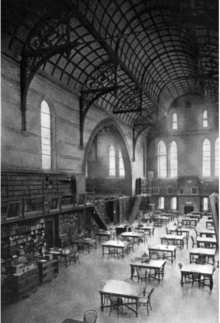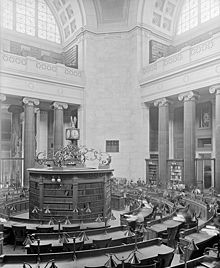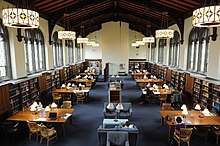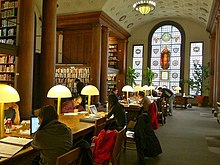
Columbia University, officially titled as Columbia University in the City of New York, is a private Ivy League research university in New York City. Established in 1754 as King's College on the grounds of Trinity Church in Manhattan, it is the oldest institution of higher education in New York and the fifth-oldest in the United States.
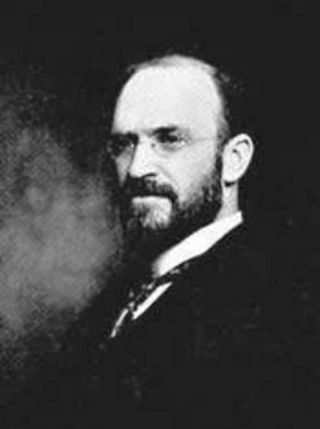
Melville Louis Kossuth "Melvil" Dewey was an influential American librarian and educator, inventor of the Dewey Decimal system of library classification, a founder of the Lake Placid Club, and a chief librarian at Columbia University. He was also a founding member of the American Library Association. Although Dewey's contributions to the modern library are widely recognized, his legacy is marred by allegations of sexual harassment, racism, and antisemitism.

Cambridge University Library is the main research library of the University of Cambridge. It is the largest of over 100 libraries within the university. The library is a major scholarly resource for members of the University of Cambridge and external researchers. It is often referred to within the university as the UL. Thirty-three faculty and departmental libraries are associated with the University Library for the purpose of central governance and administration, forming "Cambridge University Libraries".

The American University of Beirut (AUB) is a private, non-sectarian, and independent university chartered in New York with its campus in Beirut, Lebanon. AUB is governed by a private, autonomous board of trustees and offers programs leading to bachelor's, master's, MD, and PhD degrees.

Harvard Library is the network of Harvard University's libraries and services. It is the oldest library system in the United States and both the largest academic library and largest private library in the world. Its collection holds over 20 million volumes, 400 million manuscripts, 10 million photographs, and one million maps.

A law library is a special library used by law students, lawyers, judges and their law clerks, historians and other scholars of legal history in order to research the law. Law libraries are also used by people who draft or advocate for new laws, e.g. legislators and others who work in state government, local government, and legislative counsel offices or the U.S. Office of Law Revision Counsel and lobbying professionals. Self-represented, or pro se, litigants also use law libraries.
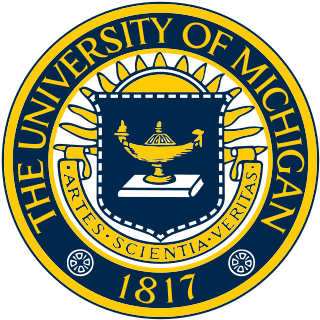
The University of Michigan Library is the academic library system of the University of Michigan. The university's 38 constituent and affiliated libraries together make it the second largest research library by number of volumes in the United States.

An academic library is a library that is attached to a higher education institution and serves two complementary purposes: to support the curriculum and the research of the university faculty and students. It is unknown how many academic libraries there are worldwide. An academic and research portal maintained by UNESCO links to 3,785 libraries. According to the National Center for Education Statistics, there are an estimated 3,700 academic libraries in the United States. In the past, the material for class readings, intended to supplement lectures as prescribed by the instructor, has been called reserves. Previously before the electronic appliances became available, the reserves were supplied as actual books or as photocopies of appropriate journal articles. Modern academic libraries generally also provide access to electronic resources.

The Yale University Library is the library system of Yale University in New Haven, Connecticut. Originating in 1701 with the gift of several dozen books to a new "Collegiate School," the library's collection now contains approximately 14.9 million volumes housed in fifteen university buildings and is the fourth-largest academic library in North America.

The library system of the University of California, Los Angeles, is one of the largest academic research libraries in North America, with a collection of over twelve million books and 100,000 serials. The UCLA Library System is spread over 12 libraries, 12 other archives, reading rooms, research centers and the Southern Regional Library Facility, which serves as a remote storage facility for southern UC campuses. It is among the ten largest academic research library systems in the United States, and its annual budget allocates $10 million for the procurement of digital and print material. It is a Federal Depository Library, California State Depository Library, and United Nations Depository Library.

The Rare Book & Manuscript Library is principal repository for special collections of Columbia University. Located in New York City on the university's Morningside Heights campus, its collections span more than 4,000 years, from early Mesopotamia to the present day, and span a variety of formats: cuneiform tablets, papyri, and ostraca, medieval and Renaissance manuscripts, early printed books, works of art, posters, photographs, realia, sound and moving image recordings, and born-digital archives. Areas of collecting emphasis include American history, Russian and East European émigré history and culture, Columbia University history, comics and cartoons, philanthropy and social reform, the history of mathematics, human rights advocacy, Hebraica and Judaica, Latino arts and activism, literature and publishing, medieval and Renaissance manuscripts, oral history, performing arts, and printing history and the book arts.

The William F. Ekstrom Library is the main branch of the University of Louisville Libraries system. Located on the university's Belknap Campus in Louisville, Kentucky, Ekstrom Library contains collections in the humanities, sciences, and social sciences. The University of Louisville Libraries is a member of the Association of Research Libraries (ARL) and, along with Ekstrom, includes libraries for Art, Health Sciences, Law, and Music, as well as the Archives and Special Collections. The University of Louisville Libraries hold approximately 2.2 million print volumes, subscribe to several thousand serials, and provide full-text electronic access to approximately 74,000 journals. Ekstrom is a Federal Depository Library and houses the largest selective government document collection in Kentucky.

Louis Round Wilson was an important figure to the field of library science, and is listed in "100 of the most important leaders we had in the 20th century," an article in the December 1999 issue of American Libraries. The article lists what he did for the field of library science including dean at the University of Chicago Graduate Library School, directing the library at the University of North Carolina/Chapel Hill, and as one of the “internationally oriented library leaders in the U.S. who contributed much of the early history of the International Federation of Library Associations and Institutions.” The Louis Round Wilson Library is named after him.
The University of North Texas Libraries is an American academic research library system that serves the constituent colleges and schools of University of North Texas in Denton. The phrase "University of North Texas Libraries" encompasses three aspects: The library collections as a whole and its organizational structure; The physical facilities and digital platform that house the collections; and certain self-contained collections of substantial size that warrant the name "Library"—the Music Library and the Digital Libraries (collections), for example, are housed in Willis Library.

Burke Library of the Union Theological Seminary is located at 3041 Broadway, in the Morningside Heights neighborhood of Manhattan, New York City. Founded in 1838, since 2004 it has been a part of the Columbia University Libraries. Holding over 700,000 items, it is one of the largest theological libraries in North America.
The Jewish Theological Seminary Library is one of the largest Jewish libraries in the world. Founded in 1893, it is located at the Jewish Theological Seminary of America in New York City, New York, and holds over 400,000 volumes, as well as extensive rare materials collections, including the world's largest collection of Hebrew manuscripts. Its holdings have been described as "the most impressive compilation of Jewish historical materials outside of Jerusalem." The library is an affiliate of the Columbia University Libraries.
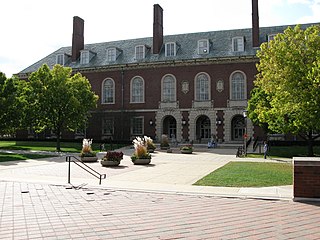
The University Library at the University of Illinois Urbana–Champaign is the network of libraries, including both physical and virtual library spaces, which serves the university's students, faculty, and staff, as well as scholars and researchers worldwide. The University Library continues to evolve to serve the needs of the University of Illinois Urbana–Champaign campus.
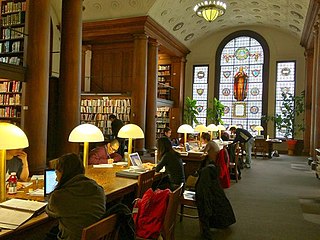
The C.V. Starr East Asian Library is a library at Columbia University, holding collections for the study of East Asia in the United States. It is one of the largest East Asian libraries in North America, consisting of over one million volumes of Chinese, Japanese, Korean, Tibetan, Mongolian, Manchu, and Western-language materials, almost 7,500 periodical titles, and extensive special collections. It is located in Kent Hall, on the university's Morningside Heights campus.
The Arthur W. Diamond Law Library is the law library of Columbia Law School. Located in Jerome L. Greene Hall on the university's Morningside Heights campus, it holds over 1.3 million volumes, and as of 2021, it is the second largest academic law library in the United States. It was named for alumnus Arthur W. Diamond following a $7 million donation from the Miriam and Arthur W. Diamond Charitable Trust to Columbia Law School.
Beverly Robinson Betts was an American reverend and librarian, who served as the first "professional" librarian of the Columbia University Libraries.


